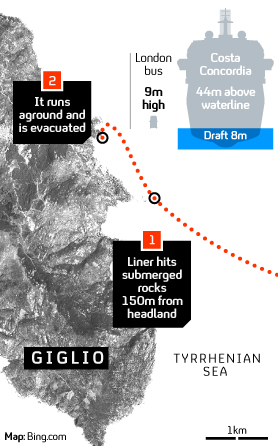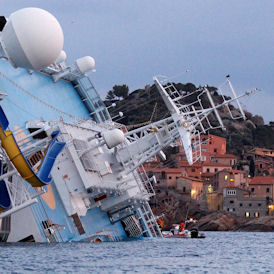How safe are cruise ships?
In the wake of the Costa Concordia disaster, the union for maritime professionals tells Channel 4 News some safety features of cruise ships have hardly moved on since the Titanic sank 100 years ago.

Rescue workers are still searching for survivors after the massive Costa Concordia hit a rock near the Italian island of Giglio on Friday.
But maritime experts say that the incident, in which at least six people have died, could have been avoided – and should be seen as a wake-up call for the industry 100 years on from the sinking of the Titanic.
Mark Dickinson, the general secretary of Nautilus International, the union for maritime professionals, said: “In this, the centenary of the loss of the Titanic, a major nostalgia industry is already in full flow – but it is essential that everyone recognises that the Titanic offers lessons for today…
“Many ships are now effectively small towns at sea, and the sheer number of people onboard raises serious questions about evacuation. Nautilus is by no means alone in voicing concern at underlying safety issues arising from the new generation of ‘mega-ships’.”
Indeed, the spokesman for Nautilus told Channel 4 News that some of the safety features on board the “mega-ships” have hardly improved since 1912.
He said: “Lifeboat technology is pretty old. It hasn’t moved on radically from the era of the Titanic. The basic systems are not a million miles away from what we had 100 years ago.”
There are better systems, but they are not currently required under the International Maritime Organisation‘s regulations. Nautilus believes that these regulations need to be revisited across the board – not just regarding lifeboats but on the safety and stability of the ships themselves.
It also has concerns over the evacuation procedures as well as the electronic charts used to navigate on many modern ships, which are often complex and, in some cases, can be out of date.
Images from the Costa Concordia tragedy
“People are saying how could this happen in the 21st century, but the charts are only as good as the data they are built upon, and there are lots of concerns about the surveys – some are woefully out of date, well over 100 years,” he said.
He added: “This is not a new concern. There has been an inexorable increase in the size of cruise ships which we don’t believe has been fully matched in all sorts of areas – there are fundamental questions over the design and stability of a lot of the vessels.”
‘Human error’
In Italy, investigations into the accident are focusing on the role of the captain, who was arrested on Saturday – including whether he made an unauthorised “sail-by” too close to the island. The ship’s operator Costa Crociere said on Monday: “We cannot deny human error”.
The Nautilus spokesman told Channel 4 News that between 60 and 80 per cent of accidents at sea have human factors involved.

“Again, there’s a lot of concern within the industry among seafarers in particular over some of the technology and training given to captains and navigation officers,” he said.
“One of the worries we’ve got is the desire to make a scapegoat for the accident – the captain seems to be in the firing line but again the crew is only as good as the equipment and training they are given and some fairly fundamental questions need to be asked about some of the equipment and support seafarers are given to deal with all this.”
However, other cruise industry experts maintain that the industry is already asking these key safety questions.
‘Safer than airlines’
Peter Wild, founder of GP Wild, a maritime consultancy business which specialises in cruise industry research, told Channel 4 News cruise ships have very good safety records.
“From 2005 to 2010, the average fatalities per one million passengers was less than 0.1, which is better than the airline industry, which is 0.3 per million passengers. So it’s three times safer than airlines,” he said.
He said that the industry tries to stay ahead of the regulations.
“Safety is under constant review – for example there have been some quite significant changes to the locations of lifeboats. On large ships like the Costa, the lifeboats were too high so they have taken them down to make them easier to get away from the ship and safer for passengers,” he said.
“Although you can see some lifeboats still attached to the ship, as far as I can see of the 24 lifeboats on board, 20 took passengers to safety.”
He added: “Unfortunately in extreme situations like this there will always be something that doesn’t work. Sadly, that’s the nature of these things. But overall I feel the system has saved an awful lot of lives.”
However, the Nautilus union is not convinced. Its spokesman told Channel 4 News that, while human error will never be totally eradicated, Nautilus believes the safety systems can be made secure enough to ensure that human error does not lead to catastrophe.
“There should be enough capacity within the system to protect against that,” he said.